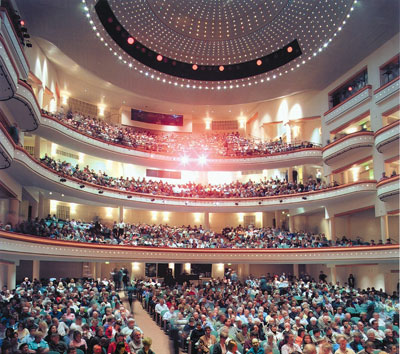 |  |  | |
News & Notices
News From:
Commissions
Costumes
Conference & Stage Expo
For the Record
 | The NC Blumenthal Performing Arts Center is just one of many venues which make Charlotte a vibrate performing arts community. Photo/Courtesy Visit Charlotte | |
| Queen City: A Gem of the South Charlotte, the Queen City, has been good to me for six years now. I arrived in 2004 and have had plenty of time to discover many of the hidden gems and interesting factoids which those planning to attend the 2011 USITT Annual Conference & Stage Expo will enjoy. Charlotte was originally named after Queen Sophie Charlotte of Mecklenburg-Strelitz, a patroness of the arts who also happened to be the wife of King George III of England and the mother of 15 children. If you arrive via the airport, you will see her statue surrounded by a fountain just outside the arrival gates. Charlotte was founded in 1768 as a cotton town, and since then has grown into a major financial and Fortune 500 hub with 326 of the top 500 companies taking advantage of the city's pro-business environment. Charlotte is the second largest financial center in the United States with the nation's largest bank, Bank of America, having roots in Charlotte for over a century. In 1798, the first gold rush began in Charlotte. Conrad Reed, a 12-year-old boy, used a 17-pound nugget as a door stop for years before his dad sold it for $3.50, that was until he found out it was actually worth thousands more! This was the first gold discovered in the United States, and Reed Gold Mine soon became open for business. Although most of the gold mines have since been closed down, the recent rise in gold prices has sent people hunting again. For your own piece of gold, stop by the Cotton Patch Gold Mine while visiting the area. "Uptown" or "Downtown," or even "Center City" depending if you are from the area or just arriving, is the only part of the city on a grid system. The rest of Charlotte resembles Paris, with all roads radiating toward and away from the city center. Originally the city was divided into four sections, called wards, with Tryon and Trade Streets serving as dividers. Although most of the wards have been dismantled to make room for new construction, the fourth ward was placed on the historic registry in order to preserve its enviable Victorian architecture. It is within easy walking distance of the Convention Center as it remains inside the uptown loop. The neighborhoods just outside of uptown that will require a car, but should not be missed, include Dilworth, the South End, Elizabeth, Myers Park, Plaza-Midwood, South Park, NoDa, and University City. Beyond the city limits, places of interest include two of the Catawba River's largest watersheds (Lake Norman and Lake Wylie), the historic town of Davidson, the NASCAR resort area of Concord, Gastonia, Ballentyne, and Fort Mill, South Carolina (home to Carowinds amusement park). Those planning to be at USITT in 2011 should not forget their antihistamines, because the emerald city will be in full bloom for USITT next year. If you fly in during the day, you will see skyscrapers soaring above a sea of green punctuated by patches of purple and white. It's not called the "City of Trees" gratuitously. On a sunny spring day, the city sparkles like the magical city of Oz. Geography buffs may be interested in knowing the following facts. Charlotte is 765 feet above sea level, and totals approximately 242 square miles. The average annual rainfall is 43.5 inches; the average daily temperature is 39.3°F in January and 79.3°F in July. Charlotte is located in the southern part of the state of North Carolina and is part of the agriculturally rich Carolina piedmont. | ||
United States Institute for Theatre Technology, Inc.: © 2010 Volume L, Number 6